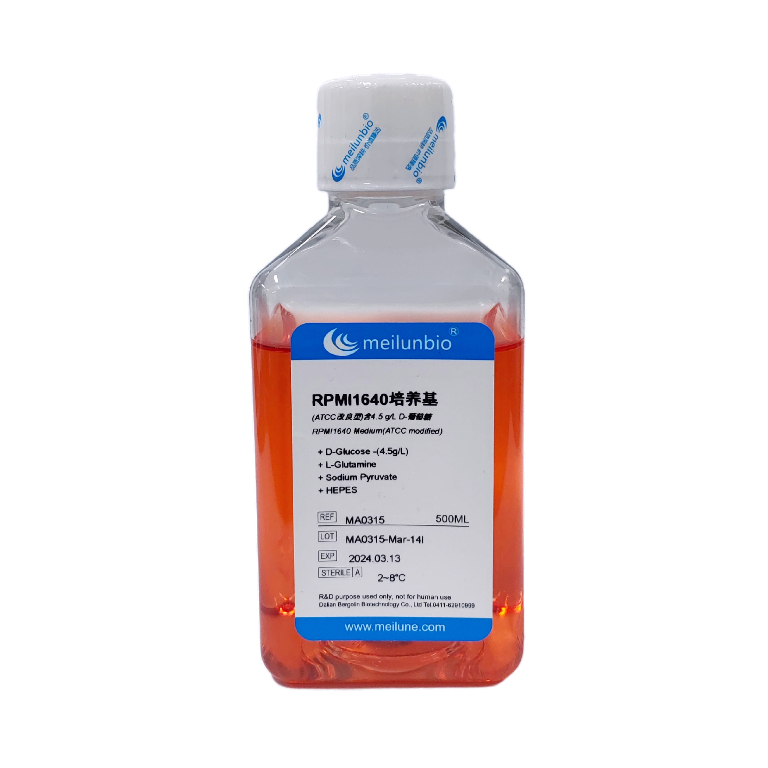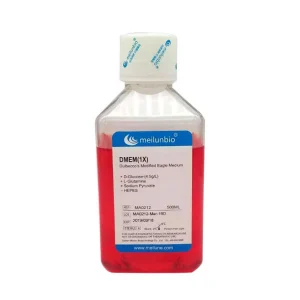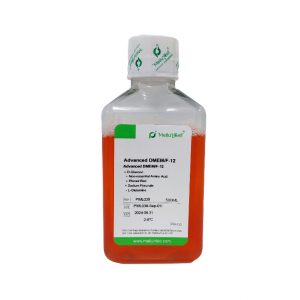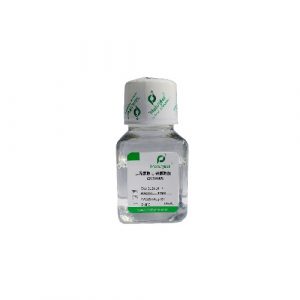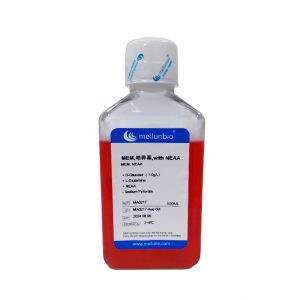Product Description
RPMI 1640 medium is named after the Roswell Park Memorial Institute, where it was developed, with “1640” indicating its medium code. It is an improved version of McCoy’s 5A medium, using a bicarbonate buffering system. RPMI 1640 medium was initially designed for culturing human leukemia cells, both in suspension and monolayers, but has since been found to be suitable for a wide range of mammalian cells, including HeLa, Jurkat, MCF-7, PC-12, PBMC, astrocytes, and various cancer cells.
RPMI 1640 medium distinguishes itself from other media by containing reduced glutathione and high concentrations of vitamins. It also contains certain nutrients not found in EMEM and DMEM, such as biotin, vitamin B12, and para-aminobenzoic acid, as well as high concentrations of choline chloride and inositol.
RPMI 1640 medium (ATCC modified) is an enhanced version of standard RPMI 1640, with additional sodium pyruvate and HEPES, increased glucose content, and reduced sodium bicarbonate content.
This McCOY’s 5A is modified as follows:
| With | Without |
| High glucose (4.5g/L) | |
| L-Glutamine | |
| Sodium Pyruvate (1mM) | |
| HEPES (10mM) | |
| Low sodium bicarbonate (1.5g/L) | |
| Phenol Red | |
| Please refer to the instruction manual for detailed formulation. | |
Quality Control Index and Basis
- Appearance and Clarity (Appendix IXB of the Pharmacopoeia of the People’s Republic of China, 2010 Edition, Part II)
- pH value (Appendix VIH of the Pharmacopoeia of the People’s Republic of China, 2010 Edition, Part II)
- Osmolality (Appendix IXG of the Pharmacopoeia of the People’s Republic of China, 2010 Edition, Part II)
- Bacterial endotoxin (Appendix IXE to the Pharmacopoeia of the People’s Republic of China 2010 Edition Part II)
- Microbial Limit (Appendix IXJ to Part II of the Pharmacopoeia of the People’s Republic of China 2010 Edition)
- Cell growth test (Chemical Industry Standard of the People’s Republic of China “Mammalian Animal Cell Culture Media” HG/T3935-2007 Article 707)
Cell Growth Test
Test basis: Chemical industry standard of the People’s Republic of China “Mammalian animal cell culture medium” HG/T3935-2007 Article 707
Method:
- Inoculate the cells into 6-well plates at 5×10^4/ml, 6 wells per cell per medium (3 wells for 48h assay + 3 wells for 48h change of media), the starting medium is the medium to be tested containing 5% FBS.
- After 48h of static incubation in the incubator, cells from the 3 assay wells in each plate were digested and collected. And the cells were counted and viability was determined using a cell counter.
- The medium in another 3 wells was discarded and FBS-free medium to be tested was added.
- After continuing to incubate in the incubator for 48h, the cells in the fluid exchange wells were digested. Counting and viability assays were performed using a cell counter.
Stability Test
- Testing basis: industry standards and ICH guidelines
- Routine stability data: recommended shelf life of 12 months, respectively, in 2-8 ℃ storage conditions to test the stability of 3 months, 6 months, 12 months, 16 months, the results are not significantly different, in line with the quality control standards
Accelerated Destruction Test
The product was stored in an Electro-heating standing-temperature incubator and tested for stability at 37℃ and 45℃ respectively. At each temperature, divided into three groups: positive placement, inverted placement, horizontal placement; selected 8 hours, 24 hours, 48 hours, 72 hours node for testing. Product stability is good, no significant statistical differences.
Constant Temperature Transportation Simulation Test
The product was ordinary packaged by Shentong Express on July 12 from Dalian to Hainan, arrived on July 19th. Then immediately returned by Shentong Express, received on July 27th. Then tested, the product stability is good, no statistical difference, in line with the constant temperature transportation conditions
Comparison of the results of cell culture medium with similar products form international brands
| Cell Culture Media | Cell | Brands | +5% FBS culture 48h | Change of media, w/o FBS culture 48h | ||
| Number of cells (pcs/ml) | Survival rate | Number of cells (pcs/ml) | Survival rate | |||
| RPMI1640 (ATCC modified) | L-292 | G Brand | 1.10 x10^5 | 94.4% | 1.21 x10^5 | 96.7% |
| MA0315 | 1.48 x10^5 ↑ | 94.2% | 2.69 x10^5 ↑ | 94.6% | ||
| 293T | G Brand | 2.13 x10^5 | 90.8% | 2.35 x10^5 | 95.5% | |
| MA0315 | 2.19 x10^5 ↑ | 92.6% | 2.33 x10^5 | 94.6% | ||
| HCT116 | G Brand | 2.00 x10^5 | 90.8% | 3.54 x10^5 | 97.2% | |
| MA0315 | 2.24 x10^5 ↑ | 93.0% | 4.13 x10^5 ↑ | 96.5% | ||
| NCI-H460 | G Brand | 2.94 x10^5 | 93.8% | 9.48 x10^5 | 97.7% | |
| MA0315 | 2.85 x10^5 | 93.3% | 9.44 x10^5 ↑ | 96.4% | ||
| Vero | G Brand | 1.68 x10^5 | 93.9% | 3.24 x10^5 | 96.8% | |
| MA0315 | 1.89 x10^5 ↑ | 96.0% | 3.70 x10^5 ↑ | 97.5% | ||
CONCLUSION: MeiunBio Basic Cell Culture Media is comparable to international first-class brands in terms of cell number and survival. Moreover, the cell morphology is good under microscope and the effect of long-term cell culture is stable, so it can perfectly replace the culture media of the first-line brand.
Shipping and Storage
- Storage:Store at 2-8°C in the dark for one year.
- Shipment:Room temperature
Usage Statement
Research Use Only (RUO)
All sales are subject to the General Terms and Conditions of Sale set forth on our website.

